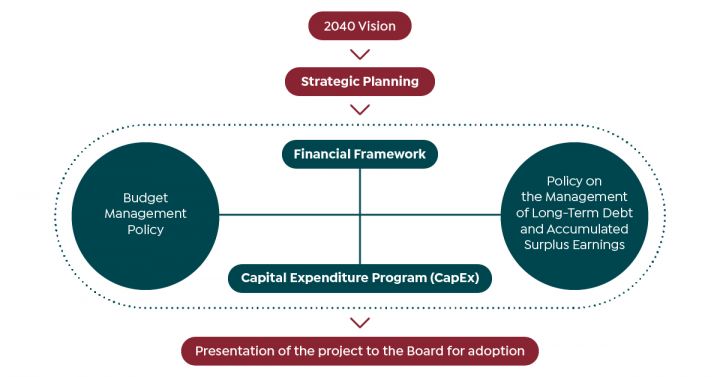Capital Expenditure Program
As provided for in the Municipal Code, the Council must adopt, each year, a three-year Capital Expenditure Program (CapEx) for the following three years. That said, the Council adopted a budget management policy in May 2024, resulting in the Municipality preparing a five-year CapEx.
Why transition to a five-year investment program?
This five-year Capital Expenditure Program will replace the former three-year CapEx. This updated strategic framework will provide more rigorous, sustainable, and transparent investment planning. It will also consider the community's needs and foster collaboration with citizens and local partners.
Financial Framework of the Municipality

Adoption of the 2025-2029 Capital Expenditure Program
The Municipal Council adopted the Capital Expenditure Program for the next five years at an extraordinary meeting held on December 16th, 2024. It includes a total investment of $54M, divided into annual phases:
- 2025: $20.2M
- 2026: $11.6M
- 2027: $14.3M
- 2028: $4.7M
- 2029: $3.2M
Explanatory document
See the official press release
Read the complete 2025-2029 Program (French only)
Understanding municipal debt
What is municipal debt? It's a method of financing a capital expenditure. This expense is incurred to purchase, build, develop, enhance or improve a capital asset. This type of borrowing makes it possible to spread the cost of long-term projects over several years rather than bearing it solely from annual revenues.
Dept Breakdown
Debt is distributed in three ways: one portion is assumed by all residents, another by a specific sector, and a third is covered by a subsidy.

Ratio of debt borne by all taxpayers to standardized property wealth (RFU)
This graph illustrates the evolution of the ratio of debt assumed by all taxpayers to RFU since 2015.

Debt Service
This graph refers to the regular payments (interest and principal) a borrower must make to service a debt.

Frequently Asked Questions
The Five-Year Capital Expenditure Plan (CapEx) represents the municipal council's investment intentions for the next five years. This document, divided into annual phases, offers a global vision of projects to anticipate financial needs. It details the purpose, amount, and method of financing the planned expenditure, which will be spread over more than 12 months. It should be noted that projects included in the CapEx are not automatically implemented; their realization depends on priorities, available resources and the results of calls for tender.
Capital expenditures enable the Municipality to maintain its assets in good condition, for example, replacing damaged roads, aging water pipes or outdated municipal buildings. They are also used to develop new projects, such as building parks, adding recreational trails or developing new infrastructures to meet the community's growing needs.
The Municipality finances CapEx projects by various means, including government subsidies and, if necessary, borrowing. If borrowing is required, it must be presented in a borrowing by-law and approved by the municipal council. This process strictly controls the amount borrowed for a specific project and its use, ensuring responsible management of public funds.
Borrowing makes it possible to finance major projects that benefit the community over several decades while avoiding imposing an excessive tax burden in the short term. This ensures balanced and equitable management of financial resources for present and future generations.
All loans must be approved by a borrowing by-law adopted by the municipal council. This by-law specifies the amounts, the projects financed and the repayment conditions. In some cases, citizens may be consulted using a register or a referendum, depending on the nature and scope of the loan.
Yes, the Municipality follows rigorous financial management principles to ensure that debt remains sustainable. Borrowing is planned based on priorities, repayment capacity, and taxpayers' impact.
The Policy on the Management of Long-Term Debt and Accumulated Surplus Earnings defines two maximum target indicators:
- Debt service ratio payable by all taxpayers
- Debt borne by all taxpayers as a function of Standardized property wealth (RFU)
These guidelines and targets guarantee prudent management that respects the Municipality's financial capacities.
Archives
Adoption of the 2024-2026 Capital Expenditure Program
The Municipal Council adopted its three-year capital expenditure plan for 2024 to 2026 at an extraordinary meeting held on December 20, 2023. It includes investments of $57M, divided into annual phases:
- 2024: $24.3M
- 2025: $10.2M
- 2026: $22.4M
Adoption of the 2023-2025 Capital Expenditure Program
Municipal Council adopted its three-year capital expenditure plan (PTI) for 2023 to 2025 at an extraordinary meeting held on November 1st. The PTI includes investments of $54M allocated over three years as follows:
- 2023: $25M
- 2024: $7.5M
- 2025: $21M
PTI projects for the year 2023:
- Community access to the river
- Improvement of road infrastructures
- Safety and mitigation measures
- Voie Verte Chelsea
- Improvement of parks and green spaces
- Investments in plants
- Land acquisition and development of the territory
- Fire security
Click here to consult the complete 2023-2025 PTI (French only).
For information
Municipality of Chelsea



